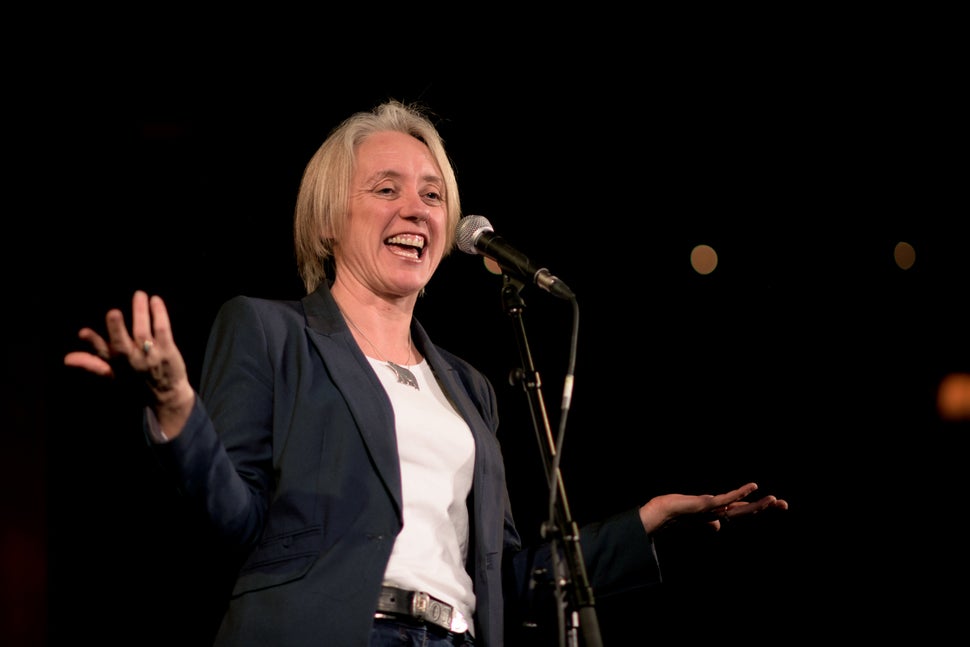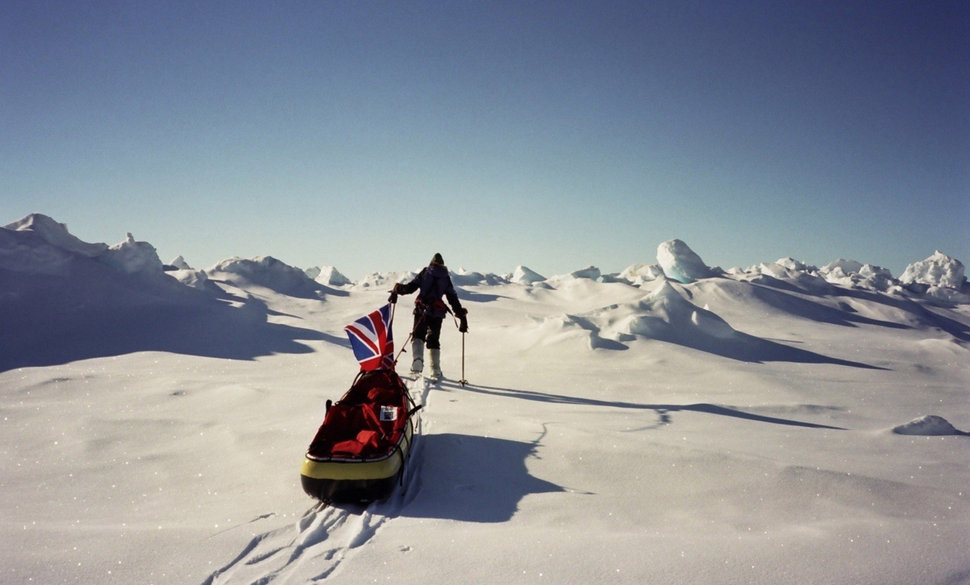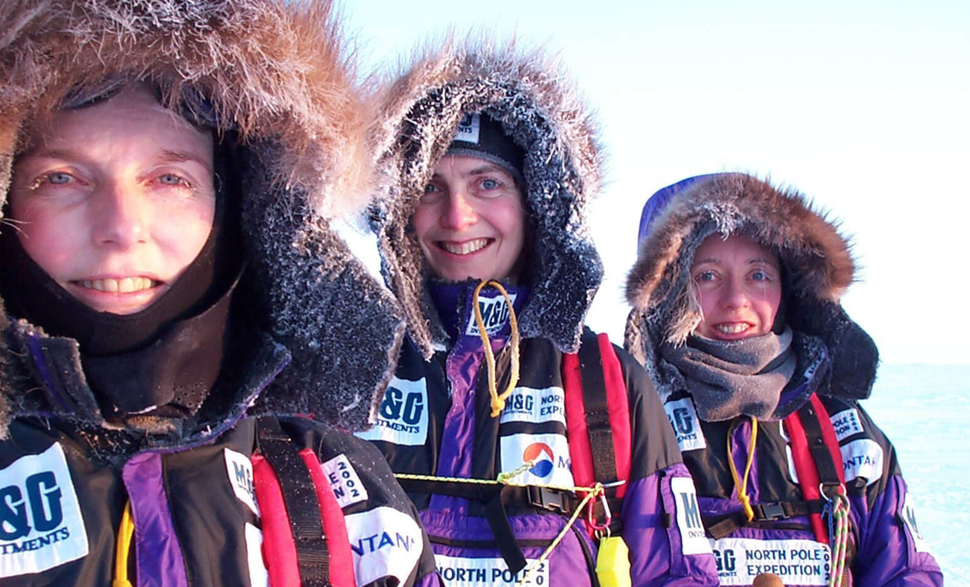

My story starts on a warm August day in 1995. I was at home playing with my eighteen-month-old triplets, and I was given an advert asking for ordinary women to apply to be part of a North Pole expedition.
Now, I had no experience. But something in this advert spoke to me. I knew my marriage was ending, and I had a bleak future, but there was hope in there.
I thought, Well, they’re asking for ordinary women, and I’m definitely that.
It didn’t occur to me at the time that I should have some outdoor experience or at least have spent a night in a tent.
It said “ordinary.” I was a mother of triplets. If I could do that, I could do anything, surely. And so I sent an application form off with seventy-five pounds that I actually couldn’t afford, and I wondered if I’d ever hear back.
But I did. A thick brown envelope arrived on my door- mat with a kit list and instructions to report to an old farmhouse in Dartmoor, where the selection was to take place.
Well, I owned nothing on this kit list. I couldn’t afford to buy anything. So I made a few calls to some military friends of mine, and within three days I had everything I needed from my feet to my head. It was all this sort of drab olive-green color, so I didn’t ask where it came from! I could go now.
I turned up on Dartmoor, and I walked into the barn. Over two hundred women had applied, and I saw them all in their outdoor kit – bright colors, all from specialist outdoor shops – and I’m in my drab green army kit.
I stood out.
The weekend started with a talk on the Arctic, and then we were marched out on Dartmoor.
It was hell, I hated it. It was cold, it was rainy.
We walked for mile upon mile upon mile. After an hour I was in so much pain I didn’t know what to do with myself. But I kept going, just putting one foot in front of the other. That’s all I could do.
When it got dark, and it was still raining, I literally sobbed with the pain, and all I could think was, Take me home, take me home.
What was I doing here?
We finished. I got to the end, and I was just going to leave it – this was not for me at all.
But then the media came down, and they interviewed everybody, but particularly me – mother of triplets – and after every interview they said to me, “What will it be like to be part of this expedition? What will it be like to go to the North Pole?”
And somewhere along those interviews, I suddenly caught the dream. This was my chance in a lifetime to do something.
But I was crap.
So I had two choices. I’d give it up or I’d give it everything.
Well, I wasn’t going to give it up.

So I went home, and I spent the next nine months on my own, with three babies, training. When they slept in the afternoon, I was in the garden, running around, doing military-style circuits. Friends taught me how to read a map and pack a rucksack. I went back in nine months’ time, and this time I was ready.
For days they put us through our paces, and the selectors tested our emotional and physical strength to the limit.We were subjected to many military-style drills and marches for hours across the moor.
At the end of it all, I was chosen. I’d made it! It was the biggest achievement of my life.
This expedition, it was a relay – five teams of four women went in relay format to the North Pole. So I actually never went the whole way. I did the first leg. Just seventeen days, and then the next team took over from us.
But it was here I fell in love with the Arctic Ocean. It was beautiful, the ice and the sounds were amazing. The expedition was just fantastic. I’d found, at the age of thirty, what I was meant to do with my life.
So I came back. Five women from that expedition, we got together and skied all the way across Antarctica, and we became the first British women’s team to ski to the South Pole.
I then began to guide expeditions in the Arctic, but a big dream was still in me – I wanted to go the whole way, to the very top of the world. So I spoke to Caroline Hamilton and Pom Oliver, my polar colleagues, and asked them to join me. At first they said no. Very few expeditions had gone the whole way to the North Pole, and no women’s team had made it, not the whole way. But I persuaded them, and eventually they agreed that we’d have a go – three women against the fierce Arctic Ocean.
We had to raise thousands of pounds for our kit, our food, our support team, and the complicated logistics of working in the high Arctic. But the hardest thing that we had to get beforehand was insurance.
It’s not your average holiday insurance, is it?
Who would insure a group of unknown women, especially a mother? We thought I would be the sticking point. The bad press that the insurance company would get if it went wrong.
We were sitting in a posh office in Canary Wharf at yet another insurance company. We could see them turning off. Suddenly, unfortunately, Pom mentioned I was a mother, and we just thought, Oh, God, Pom, that’s it! No chance.
One of the guys looked at us and went, “What, one of you has got children?”
“Yes, yes, yes, sorry.”
He said, “Well, actually that changes things,” and they had a big conversation, and they decided that they would give us insurance, because I was sure to come back for my children.
So we got it. The last piece of the jigsaw puzzle. We were going to make this happen.

I couldn’t have done any of this without my parents. They moved into my home, and they looked after my children, who were excited to be with Granny and Granddad. The hardest moment was when we said goodbye at the airport, and I saw them being really brave, trying not to cry. That was a bit of a gut wrench.
We flew from London to the high Arctic, and then we took a Twin Otter airplane up to the very last piece of land, Ward Hunt Island.
It’s five hundred miles of ice and snow to the pole from there. You need to ski, hauling sledges across the Arctic Ocean to the North Pole. We had in our sledges everything we needed for the expedition: our food, our clothing, our kit, and enough fuel to melt water.
As the plane took off, we were terrified. It was terrible terrain and really cold. There was no person for thousands of miles. All we had connecting us to the outside world was a satellite phone. The nearest airplane was two days away in good weather. It was sincerely up to us to make this journey. We just had to make that first step.
I’d been on the first leg of the relay and thought I knew what to expect, but this expedition was worse than any I had ever encountered. For the first twenty-seven days, the temperatures were between minus forty-four and minus sixty-nine degrees Fahrenheit on the thermometer. With wind chill we were simply surviving. Our sledges were too heavy – they were about twice our own body weight – and it took all three of us to haul one sledge over every ridge as we moved forward.
It was debilitating and so slow. And in the beginning we all got frostbite.
I can remember skiing at the front. I had frostbite on my middle toe and my little toe, and a little bit on my big toe, and I could feel it getting worse. But I couldn’t call a halt to the team to warm it, because we were so far behind schedule. We had endured three storms, breaking ice, backwards drift, and the worst ice conditions I’d ever encountered. We would never get there if we stopped.
I can remember thinking, Oh, God, okay, I can’t feel my middle toe. Well, oh hell, who needs a middle toe? I can live without a middle toe.
And a little toe...well, yeah, I can live without a little toe.
I can’t live without a big toe. If it starts to go for that, that’s it.
We were literally bargaining with bits of our bodies in order to make this happen.
I found on the ice that when I could think about things, I missed the children terribly. I could go about fourteen days, fifteen days – that seemed to be the limit before it affected my morale.
Pom and Caroline were really good. They would give me time with the satellite phone and the precious batteries. I’d call, and the kids were so excited to tell me about everything they were doing and how great it all was. They chattered, and I listened, and when I put the phone down, I was filled with them again, and I could keep going.
If I had trouble with frostbite, Pom was the worst. All her toes were frostbitten, and after forty-seven days we had a resupply plane that came in to give us new food and fuel, and Pom had to leave.
I never thought about getting on that plane, even though the chances of us getting to the pole were so slim. On day thirty-seven of the expedition, before Pom left, we’d gone just sixty-nine miles of the five hundred. We’d gone a few more in the next ten days, but we still had over three hundred miles to go. It was impossible. But we weren’t going to give in.
It was now just me and Caroline. And although we missed Pom, when she left, we began to use her as our motivation. “We’ll do this for Pom. We’ll do another hour for her.”
We became one driving force. We swam through open water, we skied across thin ice. We added hours to our days. Because we were walking across the Arctic Ocean, the ice moved constantly – always against us. So some nights we would get into our frozen sleeping bags that we would have to break, and as we slept, we would drift backwards.
Those were the tough nights. But eventually, after eighty gruelling days, we knew we had two hours left. We were literally feet from the pole, and we thought, This is it, this is it.
We pinpointed the North Pole with a GPS. The ice moves on the ocean so fast that, while the North Pole is a fixed place, it feels like it’s moving as the ice moves you this way and that.
You have no concept that you’re moving, so it feels like the North Pole is running away from you.
We got the GPS out and zigzagged this way and that, and we couldn’t pinpoint it. As quickly as we were getting there, the ice was moving.
“We can’t be the first women to go thirteen feet from the Pole!”
We stood there on a piece of ice, not sure what to do. We could almost hear the planes. And we looked at the GPS and the numbers and, as we looked, it started to count upwards.
We watched it moving and moving, and that piece of ice, as we stood still, moved up to the magical ninety degrees north.
We got it.
I planted the Union Jack, we sang the national anthem, and I asked Caroline if she would take a picture of me holding a photo of my children, because I felt they were there with me. I could never have made the sacrifices without them inside my very soul.
This story is cross-posted from The Moth’s latest book, Occasional Magic, for a special edition of HuffPost UK’s Life Less Ordinary blog series. You can buy the book here and listen to Ann tell her story live here.
Life Less Ordinary is a weekly blog series from HuffPost UK that showcases weird, wonderful and transformational life experiences. If you’ve got something extraordinary to share please email ukblogteam@huffpost.com with LLO in the subject line. To read more from the series, visit our dedicated page.